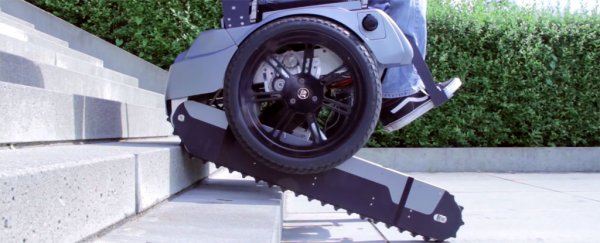
Stairs and uneven ground surfaces pose a huge problem for wheelchair users, and while ramps can improve accessibility, they're costly to implement and not always easy to retrofit to existing building structures.
Fortunately, students in Switzerland have answered this very problem with the 'Scalevo', an electric wheelchair that has the ability to ascend steps directly by lowering a tank-style tread that can roll the wheelchair up a flight of stairs.
Designed by students at ETZ Zurich and the Zurich University of the Arts, the Scalevo features gyroscopic technology that lets the wheelchair automatically balance itself on just two wheels while on flat ground (in the same manner that Segways keep upright), and when the user approaches a staircase, the wheelchair turns around and ascends the steps backwards via the caterpillar track.
"The great thing is that everything on this wheelchair is automated," said Miro Voellmy, who helped design the wheelchair's frame and support system, as reported by Jim Drury at Reuters. "If I want to climb the stairs I can just drive up to them, turn around, press one button and all I have to do is control the velocity I want to drive at."
The Scalevo travels at up to 10 km/h on flat surfaces and can ascend stairs – including spiral staircases – at a maximum speed of one step per second (which is four times faster than the speed you see demonstrated in the video above). It's been entered into this year's Cybathlon Championship – a competitive event sponsored by ETH Zurich in which racers with disabilities pilot advanced assistive devices.
"Tracks are excellent for this use case because they have a very large footprint, which makes it near impossible to tilt, and they are also very smooth so it doesn't feel like you're driving up stairs, so it just feels like you're driving up a ramp because they're so flat and they adapt to the stair profile," said Voellmy. "So it doesn't matter if the stair is wooden or metal or glass, the tracks grip and there's no danger of slipping."
In addition to letting the wheelchair climb stairs, the track mechanism can also significantly raise the height of the user to give the person operating the chair a more elevated view of things when on flat surfaces.
While the student prototypes that have been developed so far are not for sale, interest in the project has led the Scalevo's creators to consider crowd-funding a more affordable consumer version. We can't help but think there would be massive demand if the students decide to pursue the idea.
"It was built very compact, so it's not much wider than a classic manual wheelchair and it can still go under tables," said Voellmy. "[Y]ou can go through narrow doors and use it indoors without any hassle, so it's extremely compact in comparison to different wheelchairs and it's very easy to use."
